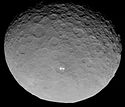 Kerwan crater. North is to the right. | |
| Feature type | Crater |
|---|---|
| Location | Ceres |
| Coordinates | 11°28′S 122°35′E / 11.47°S 122.58°E |
| Diameter | 283.88 km |
| Depth | ~5 km |
| Eponym | Kerwan, Hopi spirit of the sprouting maize [1] |
Kerwan ( /ˈkɜːrwən/) is the largest confirmed crater and one of the largest geological features on Ceres. It was discovered on February 19, 2015 from Dawn images as it approached Ceres. The crater is distinctly shallow for its size, and lacks a central peak. A central peak might have been destroyed by a 15-kilometer-wide crater at the center of Kerwan. The crater is likely to be young relative to the rest of Ceres's surface, as Kerwan has largely obliterated the cratering in the southern part of Vendimia Planitia. [2]
Kerwan is roughly antipodal to Ahuna Mons, the largest, or at least youngest, mountain on Ceres. Seismic energy from the Kerwan-forming impact may have focused on the opposite side of Ceres, fracturing the outer layers of the crust and facilitating the movement of high-viscosity cryomagma (consisting of muddy water ice softened by its content of salts) onto the surface. [3] Kerwan too shows evidence of the effects of liquid water due to impact-melting of subsurface ice. [4]
The crater is named after the Hopi spirit of sprouting maize, Kerwan. The name was approved by the IAU on July 3, 2015. [1]
See also
References
- ^ a b "Planetary Names: Crater, craters: Kerwan on Ceres". planetarynames.wr.usgs.go. IAU. Retrieved 17 July 2015.
- ^ Marchi, S et al. “The missing large impact craters on Ceres.” Nature communications vol. 7 12257. 26 Jul. 2016, doi:10.1038/ncomms12257
- ^ Ruesch, Ottoviano; et al. (2 September 2016). "Cryovolcanism on Ceres". Science. 353 (6303): aaf4286. Bibcode: 2016Sci...353.4286R. doi: 10.1126/science.aaf4286. PMID 27701087.
- ^ David A. Williams, T. Kneiss (December 2018). "The geology of the Kerwan quadrangle of dwarf planet Ceres: Investigating Ceres' oldest, largest impact basin" (PDF). Icarus. 316: 99–113. Bibcode: 2018Icar..316...99W. doi: 10.1016/j.icarus.2017.08.015. S2CID 85539501.
 Kerwan crater. North is to the right. | |
| Feature type | Crater |
|---|---|
| Location | Ceres |
| Coordinates | 11°28′S 122°35′E / 11.47°S 122.58°E |
| Diameter | 283.88 km |
| Depth | ~5 km |
| Eponym | Kerwan, Hopi spirit of the sprouting maize [1] |
Kerwan ( /ˈkɜːrwən/) is the largest confirmed crater and one of the largest geological features on Ceres. It was discovered on February 19, 2015 from Dawn images as it approached Ceres. The crater is distinctly shallow for its size, and lacks a central peak. A central peak might have been destroyed by a 15-kilometer-wide crater at the center of Kerwan. The crater is likely to be young relative to the rest of Ceres's surface, as Kerwan has largely obliterated the cratering in the southern part of Vendimia Planitia. [2]
Kerwan is roughly antipodal to Ahuna Mons, the largest, or at least youngest, mountain on Ceres. Seismic energy from the Kerwan-forming impact may have focused on the opposite side of Ceres, fracturing the outer layers of the crust and facilitating the movement of high-viscosity cryomagma (consisting of muddy water ice softened by its content of salts) onto the surface. [3] Kerwan too shows evidence of the effects of liquid water due to impact-melting of subsurface ice. [4]
The crater is named after the Hopi spirit of sprouting maize, Kerwan. The name was approved by the IAU on July 3, 2015. [1]
See also
References
- ^ a b "Planetary Names: Crater, craters: Kerwan on Ceres". planetarynames.wr.usgs.go. IAU. Retrieved 17 July 2015.
- ^ Marchi, S et al. “The missing large impact craters on Ceres.” Nature communications vol. 7 12257. 26 Jul. 2016, doi:10.1038/ncomms12257
- ^ Ruesch, Ottoviano; et al. (2 September 2016). "Cryovolcanism on Ceres". Science. 353 (6303): aaf4286. Bibcode: 2016Sci...353.4286R. doi: 10.1126/science.aaf4286. PMID 27701087.
- ^ David A. Williams, T. Kneiss (December 2018). "The geology of the Kerwan quadrangle of dwarf planet Ceres: Investigating Ceres' oldest, largest impact basin" (PDF). Icarus. 316: 99–113. Bibcode: 2018Icar..316...99W. doi: 10.1016/j.icarus.2017.08.015. S2CID 85539501.

